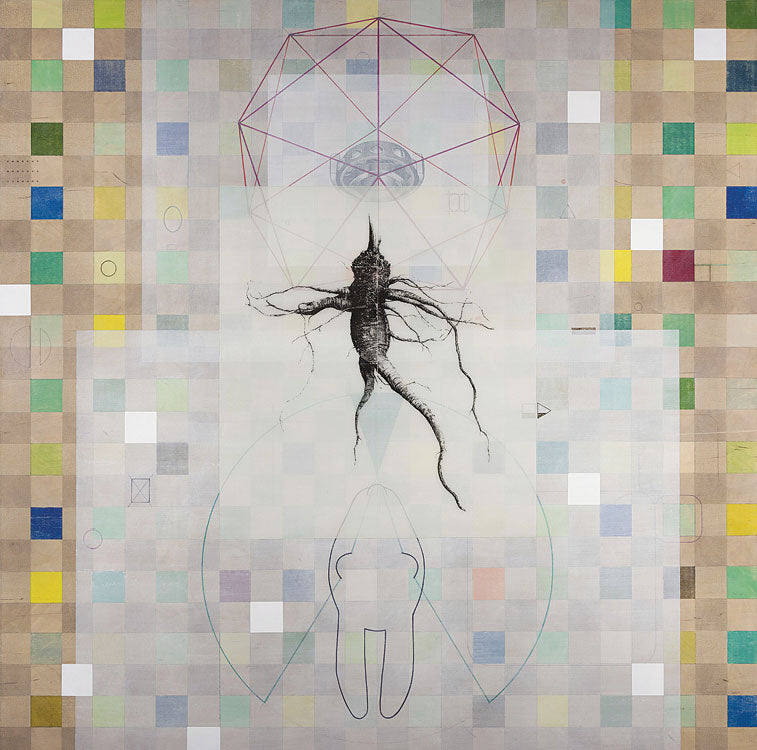Mastering Mixed Media
January 4, 2019
We got the opportunity to check in with four Canadian mixed media artists and delve into their art practices. Each artist experiments with media, forming
the basis of their art practice. Gain fresh insight into the processes of the artists, and see what you can incorporate into your own mixed media experiments.

WANDA LOCK
wandalockart.com | Instagram @wanda_lock
“If you are making something others disapprove of, you are probably on to something.” This is the message that Wanda heard years before, and she holds it close to her heart whenever she walks into the studio. “Making art that is adored by the masses is easy, but to travel down deep into a rabbit hole, now that takes courage.”
As a self-described oil painter who draws, Wanda uses all the various art materials that are available to her at any one time to help put the pieces together. Winking at a relationship with her studio, Wanda “spends days and nights chatting, sometimes arguing, about the fundamentals of art making” with her own artistic practice.
She emphasizes that there is no map or logical path for the artist to take – each visit to her studio is a fresh mystery. For her, the experience of walking into her studio and being met with the smell of linseed oil is intoxicating. To those trying to carve out a living in the arts, Wanda says she has no concrete advice – but that, in and of itself, may be a good thing. “It means the road is wide open.”
Some products Wanda enjoys working with:
Opus Watermedia Paper |
Montana BLACK Spray Paint |
 Derwent Coloursoft & Polychromos Colored Pencils |
Corrugated Plastic |

DEBORAH BAKOS
deborahbakos.com | Instagram @deborah_bakos_art
Experimentation is essential to Deborah’s artistic process, as it allows her to play with materials and subject matter before proceeding to a finished piece. “Even though it can feel like I am taking a step backwards every time I try something new, experimentation is ultimately about learning.” Being invested in the idea that her work can and will continue to evolve is critical to Deborah, and she uses it as a means of staying engaged with her work.
If you’re thinking of your own mixed media practice, Deborah advises to “think big, but start small.” For Deborah, this process takes form in producing dozens of small study pieces. Without investing too much money or time, she is able to quickly learn which materials and subject matter she should pursue to create finished works, and which studies should be abandoned.
These experiments also feed her creativity. Though they’re fast pieces for the purpose of experimentation, they often become her favourite because of the looseness and spontaneity she achieves when creating them.
Some products Deborah enjoys working with:
Gamblin Cold Wax |
Silicone Scrapers |
 Digital Printing |
Birch Panels |

GREGG STEFFENSEN
greggsteffensen.net | Instagram @gregg.steffensen
“We don’t make mistakes, just happy little accidents.” This quote by influential painter Bob Ross is featured prominently on the about page of Gregg’s website, and relates well to his thoughts on experimentation. “Do not place rules on how you achieve an image,” says Gregg, for whom mixed media experimentation is permission to explore non-traditional materials and techniques.
Reacting and responding to each stage of his work means that Gregg can begin with a skeletal framework or idea, and work with the media to get at the finished piece. Gregg’s goal is to facilitate a dialogue between humans and mechanical environments, focusing visually on decommissioned, abandoned, and forgotten sites and structures as a means of self discovery.
Gregg highly recommends testing the materials beforehand and when using non-traditional materials. Because they are not traditional, and potentially unexplored, Gregg advises that you “ensure they can meet archival qualities.” Working beyond the jpeg, Gregg uses low-quality photocopies in his photo transfers process, and incorporates them into his pieces.
Some products Gregg enjoys working with:
Opus Cradled Wood Panels |
Liquitex Clear Gesso |
Opus Gloss Medium |
GOLDEN Fluid Acrylics |

ANDREA SOOS
andreasoosart.com | Instagram @andreasoosart
“Process over product,” is Andrea’s mantra in the studio. It represents a constant reminder that everything she does goes towards building her practice. The process of playing with new styles and materials has helped Andrea discover a style that is true to her.
Refusing to stay contently in one style in her practice, Andrea’s art practice itself has become a constant source of play and discovery. She most enjoys the beginning and the middle portion of a painting, where she gets to fully experience the process of intuition and experimentation.
Andrea’s advice, which she has given to her students over the last 20 years, is to just do the work: play, practice, and experiment, without needing everything to be perfect. “Give yourself permission to play, and enjoy the process.”
Catch Andrea Soos at Opus North Vancouver for her demonstration Permission to Play on February 10, 2019, where she will be demonstrating a variety of techniques and materials – such as collage, spray paint, illustration, and acrylic painting.
Some products Andrea enjoys working with:
Posca Markers |
Cradled Wood Panels |
Spray Paint |
Canvas |
Ready to try your hand at enhanced digital prints?
Visit opusartsupplies.com/beyondthejpeg to discover ways you can get started with using digital prints in your creative practice to create new and exciting artworks, and even series on a theme. Have fun, explore, enjoy, and then be sure to share your creations with us on Instagram using the hashtag #opusartsupplies! We’d love to see how you play with the limitless possibilities this mixed media format allows for.
